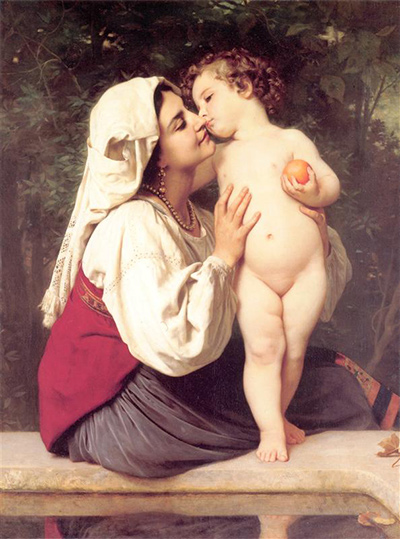 Buy Art Prints Now
Buy Art Prints Nowfrom Amazon
* As an Amazon Associate, and partner with Google Adsense and Ezoic, I earn from qualifying purchases.
Bouguereau appears to treasure the concept of maternal love so much that he is willing to integrate it into his works.
His painting, The Kiss (1863) is a vivid illustration of this concept.
The art features two people, a young female, and a child. The young lady and the child are exchanging a kiss; hence, the title of the image.
The baby is holding an egg in its hand. In the background, a distinct characteristic of Bouguereau’s works: natural vegetation. The lady is sitting on a raised platform, and the child is standing barefoot so that they can go head to head to exchange a moment of passion.
The Kiss (1863) raises the whole issue of parental love in this painting. Bouguereau seems to be providing ways in which parents should express their love to the young ones.
In this picture, a young lady tenderly holds a child and kisses it. The egg is the baby’s hand must have come from the mother. It could be argued that the egg stands for the gifts that parents ought to present to their children.
The setting is also curious: in the open, with natural vegetation forming the background. The artist seems to be vouching for pure love between mothers and their offspring.
True to his nature, Bouguereau arouses curiosity in this painting. For one, the father figure is conspicuously missing from the equation. The painter is apparently ambiguous about the role of fathers in the lives of their children. The child also seems to be reciprocating the kiss.
It is open to interpretation whether it understands the importance of such a gesture. It is also important to note that the child is completely naked, while the mother is fully dressed.
William-Adolphe Bouguereau shows a bias for the female figures in this painting as he deliberately omits the father from the equation. A closer look at the child reveals that it is also female. This image is among the many that Bouguereau has produced, featuring only female characters. There must be a particular resonance between the artist and the female figures.
The Kiss (1863) is one of the greatest paintings by Bouguereau. As expected, it brings out the art’s fascination with women, as well as the theme of maternal love.




